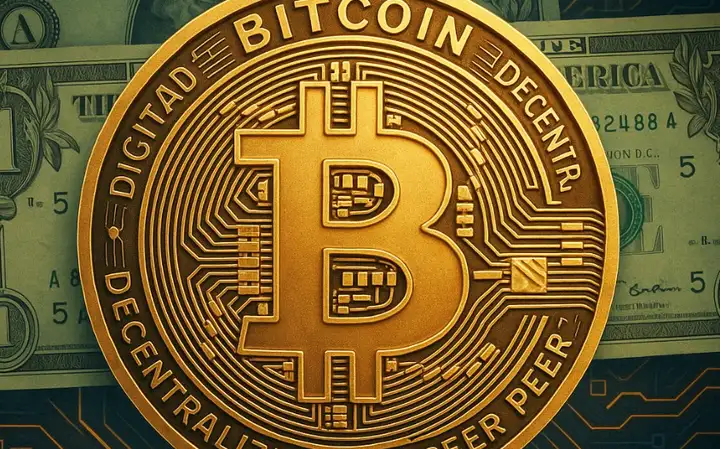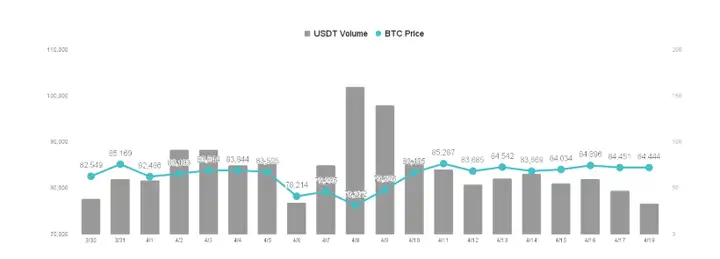For Bitcoin, the current economic situation is actually boosting its fundamental value, with recent prices remaining quite stable. For example, global confidence in the US economic prospects is currently poor, leading to a continuous weakening of the US dollar and market concerns that Trump's volatile trade policies may be undermining the dollar's status as a "safe-haven currency", thereby impacting the US economy.
VX: TZ7971
This is rewriting existing trading rules. Under trade policy volatility, investors traditionally sold risky assets and bought US dollars for safety, but a different phenomenon is emerging: since Trump announced comprehensive tariffs on April 2nd, the S&P 500 index dropped 7%, while the dollar index reflecting exchange rates against a basket of currencies also fell 4%.

The traditional correlation between the US dollar and safe-haven assets is rapidly changing. Some believe this is due to leveraged investors selling dollar assets to offset losses in other markets, while others think it shows reduced foreign investor confidence in the US economy. We believe both factors are at play, not just a single cause. Large funds from other countries, even government retirement funds, are gradually withdrawing from the US, with deleveraging and reduced buying being factual, and increased selling being another reason.
US Treasury bonds are at the center of the recent storm. Rising bond yields also reflect that the dollar is no longer the sole safe haven. Between April 2nd and 11th, 10-year Treasury bond yields rose from 4.2% to 4.5%, weakening in sync with the dollar. Gold rose 6% during the same period, and the Japanese yen appreciated by 5%, indicating investors are turning to other safe-haven assets.
Although gold and the yen cannot completely replace the dollar and US Treasuries, foreign interest in US bonds has been declining since before last year's election, with Japan and China's holdings decreasing. As Japan and China are the largest US bond buyers, if this trend continues, it will make it more difficult for the US government to support the economy through bond issuance, with borrowing costs rising and ultimately facing serious financial challenges.
To reduce borrowing costs, Trump is threatening to replace Federal Reserve (Fed) Chairman Powell unless he lowers interest rates to mitigate the economic impact of tariffs. However, Trump's legal authority to prematurely remove Powell is disputed, and the Fed is hesitant to cut rates due to concerns about worsening inflation. This heightens tensions between Trump and Powell, potentially leading to legal confrontations between the US government and the Fed, even threatening the Fed's independence.
Trump is now being attacked from both inside and outside. We believe global tariff retaliation may further escalate. Even though Trump has given a 90-day negotiation grace period, the likelihood of countries failing to reach an agreement and retaliating is increasing.

US Tariff Negotiations Starting at Least 15%, Potentially Exceeding Expectations
So far, the US government's fiscal deficit for the current year has reached $1.31 trillion, 23% higher than the same period last year. Fed Chairman Powell also stated that structural risks rising due to policy uncertainty would reduce the attractiveness of US assets.
Countries expect to negotiate and reduce US tariffs to zero through methods like investments, purchases, or lowering their own tariffs. However, Trump wants more than countries can offer, with negotiation tax rates starting at least 15% to support his next four years' fiscal deficit of $2 trillion, approximately $500 billion annually.
With US imports of $3.3 trillion last year, tariff rates would need to reach at least 15% to generate income for implementing tax cuts and fulfilling Trump's campaign promises. However, this is far from countries' expectations. Service tariffs will certainly be used as a negotiation chip, so we believe the trade war will continue to intensify. With global de-dollarization and potential economic recession risks from tariff policies, interest rate cuts and balancing measures are foreseeable. Leveraging Bitcoin's value storage characteristics, it will likely perform well in the medium to long term, especially compared to the relatively weak and confidence-shaken dollar.
Today's panic index is 39, still in a state of panic.
Bitcoin is approaching 8.8, nearing the pressure zone of 8-8.8 that I previously mentioned. Those who got in at 8.3 can actually exit now, and intraday observations of the 8.8 breakthrough are recommended. The current market is moving exactly as we analyzed and expected. Previous reports consistently suggested UNI at 5 and JUP at 0.3 could be bought. Currently, UNI is at 5.4 and JUP is at 0.4, so those who bought can continue holding, with potential multiple-fold returns. Replacing Powell seems unlikely at the moment, so this wave doesn't seem like it will surge directly upward.






